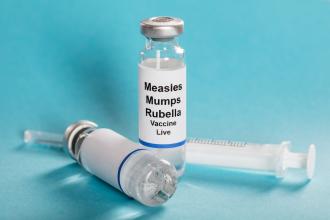Reducing immunization injection pain in infants
There is no doubt that vaccines have had a major impact on the health of children.[1] However, it has also been acknowledged that immunizations are the most common cause of pain related to medical procedures in healthy infants and children.[2] In BC, the immunization schedule calls for 13 to 15 separate injections before the seventh birthday.[3] Evidence-based, safe, and effective ways to reduce pain exist; however, these are underutilized by parents and providers, and parents report receiving little education or information about how to manage pain related to their child’s immunizations.[4-7]
There is increasing evidence that experiencing pain in early infancy could increase pain perception throughout childhood. Moreover, untreated needle pain can lead to needle fear and subsequent needle avoidance.[7] A survey conducted by Taddio and colleagues found that about two-thirds of children and one-quarter of adults acknowledged some degree of needle fear. Furthermore, 5% of parents reported avoiding or delaying their child’s immunization due to their child’s needle fear.[6] Parents trust information provided by physicians,[7,8] making family physicians an important source of information for pain management.
In 2012 the BCCDC adapted injection pain management guidelines originally published by Taddio and collegaues.[9] These are summarized as follows.[10]
• Psychological interventions: Encourage parents to stay calm, speak in a soft tone, and use age-appropriate distractions such as toys, bubbles, or singing.[3] Parents find it difficult to watch their infants be immunized,[8] and the child’s pain and distress may increase if the parent is also distressed.[7]
• Breastfeeding: Encourage mothers to breastfeed before, during, and after the immunization. Breastfeeding incorporates several principles of pain relief including tasting a sweet solution, distraction, suckling, and physical contact. Several studies have demonstrated that infants cry for a shorter period and score lower on standardized pain scales when breastfed during minor medical procedures such as immunization.[11-13]
• Sucrose solution: Offer infants who are not breastfed or who are brought to their appointment by another care giver an oral 24% sucrose solution. It is thought that sucrose works by releasing endogenous opioids and through distraction.[9] The oral rotavirus vaccine used in BC has a high enough concentration of sucrose that it may offer similar analgesic effect and should be administered prior to injected vaccines at the 2- and 4-month visits.[10]
• Immunization procedures: Advise the parent to hold the infant in a seated, comforting, and secure hold and to not place them supine. Inject vaccine without aspiration. Give the most painful vaccine last when administering multiple vaccines at the same visit; for example, administer Prevnar13 or MMRII last.[10]
• Topical anesthetics: Advise parents about the availability of topical anesthetics. These products in the form of creams and patches are effective in reducing injection-related pain and do not interfere with the immunogenicity of vaccines. While concerns have been raised that these products are expensive and can take up to 60 minutes to work, studies show that many parents are willing to purchase these products and, with adequate instruction, are able to place the cream or patch on the appropriate site.[2,8,9]
There is no one strategy that will work for every family, and what often works best is an approach combining two or more interventions. Pain is subjective and each child will react differently depending on previous experience and current context. The most important thing is that health care providers and parents alike are aware of the negative impact of pain on an infant and use the available tools to minimize pain.
For more information see the BC Immunization Manual at www.bccdc.ca/dis-cond/comm-manual/CDManualChap2.htm. Resources for parent can be found at www.immunizebc.ca/get-vaccinated/better-immunization-experience-your-child.
—Christine Halpert, RN, BSN, MA
Senior Practice Leader
—Stephanie Meier, RN, BSN
Public Health Resource Nurse
—Monika Naus, MD, FRCPC
Medical Director
hidden
This article is the opinion of the BC Centre for Disease Control and has not been peer reviewed by the BCMJ Editorial Board.
References
1. Plotkin SA, Orenstein WA. (eds). Vaccines. 4th ed. Philadelphia, PA: Elsevier Inc; 2004.
2. Schechter NL, Zempsky MD, Cohen LL, et al. Pain reduction during pediatric immunizations: Evidence-based review and recommendations. Pediatrics 2007;119;e1184-1198.
3. BC Centre for Disease Control. Communicable Disease Control Manual. Section IIA--Immunization Schedules. Accessed 20 March 2015. www.bccdc.ca/NR/rdonlyres/4E71FFD7-D9D8-4AFA-9CCE-F7218F10B394/0/Section....
4. Bender WJ. Pain and routine childhood immunizations: Is pain preventable with pharmacotherapy? S D Med 2010;63:254-255.
5. Harrison D, Elia S, Royle J, et al. Pain management strategies used during early childhood immunisation in Victoria. J Paediatr Child Health 2013;49:313-318.
6. Taddio A, Ipp M, Thivakaran S, et al. Survey of the prevalence of immunization non-compliance due to needle fears in children and adults. Vaccine 2012;30:4807-4812.
7. Taddio A, Chambers CT, Halperin SA, et al. Inadequate pain management during routine childhood immunizations: The nerve of it. Clin Ther 2009;31(suppl 2):S152-S167.
8. Parvez E, Stinson J, Boon H, et al. Mothers’ beliefs about analgesia during childhood immunization. Paediatr Child Health 2010;15:289-293.
9. Taddio A, Appleton M, Bortolussi R, et al. Reducing the pain of childhood vaccination: An evidence-based clinical practice guideline. CMAJ 2010;182:E843-855.
10. BC Centre for Disease Control. Communicable Disease Control Manual. Section IVB--Reducing Immunization Injection Pain. Accessed 20 March 2015. www.bccdc.ca/NR/rdonlyres/F837F34A-09A0-40E6-8B53-8602B8B7969A/0/Section....
11. Dilli D, Kucuk IG, Dallar Y. Interventions to reduce pain during vaccination in infancy. J Pediatr 2009;154:385-390.
12. Efe E, Ozer ZC. The use of breast-feeding for pain relief during neonatal immunization injections. Appl Nurs Res 2007;20:10-16.
13. Tansky C, Lindberg CE. Breastfeeding as a pain intervention when immunizing infants. J Nurse Practitioners 2010;6:287-295.

